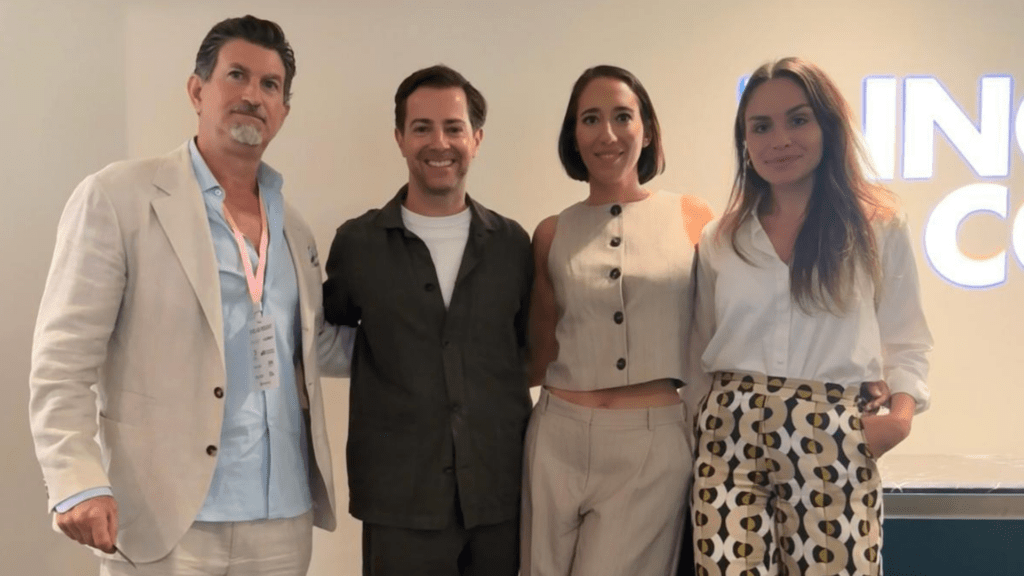Beautiful Thinking.

At INNOCOS Miami, longevity and beauty weren’t just discussed in terms of science, AI, and cellular biology, they were explored through the lens of experience. From wellness clinics and spas to community-driven longevity spaces, a panel of experts – led by our co-founder and Managing Partner, Nick Vaus – dissected how real-world environments are shaping the way people engage with health, beauty, and longevity.
Thanks to the insights and expertise of Michael Hall, Founder & CEO of the Hall Longevity Clinic, Christina Amara of everlabs, and Laura Gerchik, CEO of Wellness Curated, attendees discovered that the days of spas simply used for relaxation and pampering are long gone.
Today, they are becoming hubs of innovation, integrating cutting-edge longevity therapies, medical-grade treatments, and AI-powered health tracking to create spaces where science meets sensory experience.
These spaces are catering to a newly-discerning and demanding set of customers, as noted by Laura:
“Consumers know more now than they ever have before. If you’re a wellness space, spa, or clinic, and you’re not offering scientifically validated treatments, you’re going to lose trust. People don’t just want ‘anti-aging’ anymore—they want real, measurable results.”
While longevity research is accelerating in laboratories, the real testing ground is in wellness clinics and spas – the frontline of consumer adoption. These spaces are evolving beyond their traditional roles, becoming the bridge between clinical research and consumer lifestyle.
Spa and wellness experts have witnessed a major shift from beauty-focused services to a fully integrated health and longevity offering. Whether it’s in five-star hotels, medical wellness retreats, or high-end urban spas, consumers are no longer just looking for a facial or a massage, they want data-backed treatments that optimise their long-term health.
Michael shared:
“We need more real-time data. I’m working on a technology that creates an avatar of you – your ideal self based on biometrics and lifestyle inputs. Instead of a folder of blood tests you never look at, you’ll have a visual representation of your longevity journey. That’s where the industry is heading – integrated, trackable, and completely personalised.”
This convergence of science, beauty, and longevity medicine is shaping the future of how people experience wellness.
One of the most compelling insights from the panel was the growing intersection between longevity science and spirituality.
Ancient healing practices like energy work, sound therapy, and guided meditation are now being recognised for their impact on biological aging and stress reduction. We’re seeing longevity-focused retreats incorporating shamanic healing, frequency therapy, and ancient medicine practices alongside biomedical diagnostics. They’re not falling behind on the most progressive technology in their commitment to respected traditions; AI-driven longevity tracking is being paired with holistic interventions, allowing individuals to monitor both physiological markers and emotional well-being in real time.
As Christina observed:
“I was skeptical at first, but I’ve seen energy healing have a greater impact on someone’s health than an IV drip. Science is now proving what ancient traditions have known for centuries – that longevity is more than just biology, it’s also emotional, mental, and spiritual.”


A decade ago, there was a clear divide between luxury spa treatments and clinical interventions. But today, that line is disappearing.
Spas are integrating medical-grade treatments like laser therapies, stem cell-based skincare, and AI-driven diagnostics, while medical wellness clinics are adopting spa-like experiences to create environments that are as aesthetically pleasing as they are medically effective. Meanwhile hotels and resorts are transforming their spas into longevity spaces, recognising that travellers now seek health optimisation as part of their experience.
Laura pointed out:
“Hotels and resorts are no longer treating wellness as an add-on. They’re investing in it as a core business driver. A decade ago, a gym or spa was a nice amenity. Today, it’s a reason people book a property. Wellness is no longer a trend – it’s a fundamental part of how people travel, spend, and live.”
This shift is not just about offering treatments, it’s about creating holistic ecosystems that guide clients through their personal longevity journey.
What does longevity look like in physical space? How does a clinic, spa, or retreat feel when it is built around the principles of longevity, health, and rejuvenation?
For Christina, the founder of the everlabs wellness real estate advisory, the answer was clear:
“Health is the ultimate luxury. But why do so many wellness spaces still feel so clinical? The experience of health should be just as beautiful, seamless, and aspirational as any other luxury service.”
She has helped design premium longevity-focused wellness spaces that seamlessly blend medical-grade treatments with hospitality, ensuring that the client experience is as aesthetically refined as it is scientifically advanced.
But it’s not just about luxury design—it’s about creating environments that actively improve health. Lighting and circadian design ensures a space can help to regulate melatonin and cortisol for optimal sleep and recovery. Maximising on air and water quality creates a wellness space that enhances cellular function through purified air and hydration systems. Biophilic design and the integration of nature and organic materials into a space can help to reduce stress and improve overall well-being.
The future of wellness is moving beyond the spa and into the home, where longevity-driven design could reshape the way we live our daily lives.
While longevity is often seen as an individual pursuit, a growing trend is the rise of community-driven wellness spaces.
We’re witnessing the rapid rise of social saunas and group longevity rituals, where people engage in wellness practices together, from guided breathwork to infrared therapy. Similarly, an evolution of wellness retreats is expanding into longevity, with packages that focus on shared experiences and the blending of science-backed interventions with ancient healing traditions. Longevity members’ clubs are taking the elevated private members offering up a notch, with everything from biohacking consultations to customised supplementation in an exclusive, social wellness environment.
Yet, as Christina noted, not everyone wants community all the time:
“Longevity is deeply personal. Some people want group wellness experiences, others want solitude and precision. The future of wellness spaces will offer both.”
This hybrid approach – blending individualised longevity programs with communal wellness experiences – is sure to shape the next wave of luxury health spaces.


While the wellness industry is experiencing a gold rush of longevity-focused innovation, there’s a pressing need for standardisation, credibility, and personalisation.
Standardisation – As Michael pointed out, the industry needs evidence-based protocols that distinguish scientifically backed treatments from marketing gimmicks.
Personalisation – Laura emphasised that today’s educated consumer expects hyper-personalised wellness experiences, from AI-driven skincare to tailored supplementation.
Integration – Christina highlighted the need to bridge the gap between medicine, hospitality, and lifestyle, creating seamless longevity journeys that are both clinically effective and beautifully designed.
The future of longevity isn’t just about extending life – it’s about creating experiences that make people feel their best every day. And the spaces where this transformation happens – clinics, spas, wellness clubs, and even homes – will be just as important as the science driving it.
